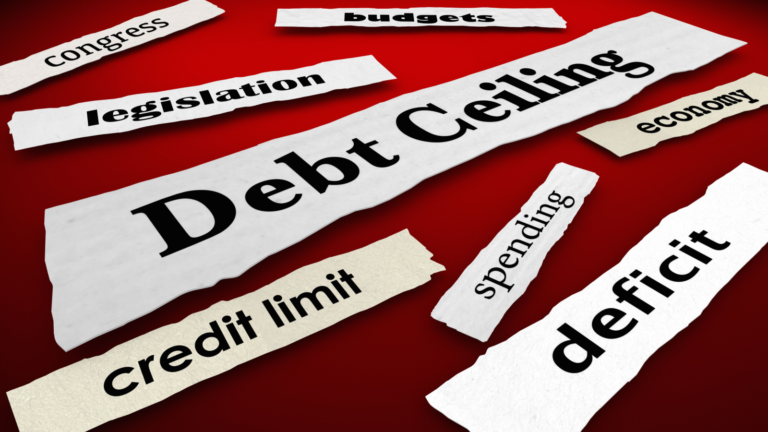Politicians are trading barbs over it. Media outlets are overhyping it. Government officials are sounding economic catastrophe alarms … The U.S. debt ceiling is back in the spotlight.
But do not let the debt ceiling drama fool you. It is just political theater. Nothing more.
For investors, it is meaningless … except for the fact that history says it could create a huge buying opportunity.
Here’s why.
Debt Ceiling Defined
First off, let’s define the debt ceiling and talk about what raising it means.
The U.S. government spends a lot of money. It funds some of that spending through tax revenues. However, the government spends a lot more than it makes in taxes. Therefore, the bulk of government spending is actually funded by debt.
The “debt ceiling” is the max amount of debt the U.S. government can have at any given time.
Back in 1917, the United States created this cap so that the government couldn’t just “run up the tab,” so to speak, and become overly indebted.
The debt ceiling is arbitrarily determined by legislators in Washington and set in nominal terms. Because it is set in nominal terms – and because the U.S. government is constantly growing – those same legislators must actively adjust the debt ceiling cap to allow for more spending to support a bigger and bigger government.
This is called “raising the debt ceiling.” It happens all the time. Over the past 60 years, the debt ceiling has been raised 89 times, or about once every eight months.
And both parties do it. The debt ceiling has been raised 36 times under Democratic presidents and 53 times under Republican ones.

This isn’t a partisan issue. Nor is it a serious one.
The debt ceiling is always being raised, and the economy always keeps spinning.
But things do start to get sticky when legislators can’t agree on a debt ceiling raise, as is the case today.
We’ve Seen This All Before
The current drama in Washington is due to the fact that Democrats and Republicans are struggling to agree on the magnitude of a debt ceiling raise.
Democrats want to raise the ceiling a whole bunch so that they can have the budget to spend more on social and welfare programs. Republicans don’t want to raise the debt ceiling because they don’t believe in the purpose or value of those government-sponsored programs.
Neither side is budging.
If they can’t come to an agreement, the U.S. Treasury will be forced to cut spending on some existing government programs and divisions to keep the government under the debt limit. If those cuts persist for a few weeks, the U.S. credit rating would be at risk of a downgrade.
This has happened once before.
Back in 2011, Democrats and Republicans weren’t at an impasse with respect to debt ceiling negotiations. They were unable to successfully raise the ceiling in time. The Treasury cut back spending on certain programs. And Standard & Poor’s downgraded the U.S. credit rating from AAA for the first time since World War II.
At the time, many investors and economists thought it was the end of the world.
They expected the downgrade to meaningfully lift borrowing costs not just for the U.S. government, but for all U.S. businesses and consumers, too. They expected the U.S. economy to lose its standing as the global economic superpower and thought the dollar would lose its position as the global reserve currency.
In the days after the credit rating downgrade, the S&P 500 dropped 8%.
But none of those fears ever materialized.
Eventually, Republicans and Democrats reached a deal, as they always do. The debt ceiling was raised. And all returned to normal.
A year later, the S&P 500 was up 20%!

The Final Word
The debt ceiling drama is spooking a lot of investors right now.
But you should know that this is just political theater.
The last time this happened, stocks gyrated wildly for a few days, then soared 20% over the next year.
We expect something very similar to play out this time.
That’s why the only real implication of the 2023 debt ceiling drama is that it could create an enormous buying opportunity.
If that buying opportunity does emerge in the coming days, we have the single best stock for you to buy.
You’ve certainly heard all the buzz about AI these days. But have you heard any buzz about AI’s secret “super power” that could create a whole new generation of mind-blowing applications?
It’s a top-secret tech that some claim will change the world more than the invention of the wheel or even the discovery of fire.
And one tiny, under-the-radar tech startup is developing the best version of this world-changing tech.
The best part? Its stock is trading for less than $10.
But time is of the essence here – because this tiny stock is already up more than 130% in 2023 alone!
Investors are starting to hear about this breakthrough tech, and they’re buying the stock up in a hurry.
Get in on the next big tech stock before it explodes to the moon.
On the date of publication, Luke Lango did not have (either directly or indirectly) any positions in the securities mentioned in this article.

